
July 29, 2023, 6 Comments
The Power of Digital Marketing: Connecting with Customers Online
Digital Marketing
Marketing has experienced a fundamental change in the quick-moving digital era giving rise to “Digital marketing. This approach uses electronic devices to convey promotional messages and measure their impact throughout the customer journey. Instead of traditional marketing which includes magazine ads, billboards, and direct mail. Digital marketing primarily targets computer, phone, tablet and other device users. It encompasses various forms, such as online videos, display ads, search engine marketing and social media posts.
-
The Importance of Digital Marketing
Tapping into the digital world is crucial given the online habits of today’s consumers. Establishing an online advertising presence can help to build a strong brand and provide an exceptional customer experience. Attracting potential customers and much more. To achieve this goal a well-crafted digital marketing strategy is essential.
-
Embracing Various Digital Channels
A successful digital marketing strategy involves utilizing different digital channels. To reach both existing customers and potential leads from new customers. Social media, PPC advertising, (SEO) and email marketing are among the powerful tools at a marketer’s disposal. Using these channels effectively businesses can not only strengthen their brand. But also engage with their audience and drive new customer acquisition.
-
The Online Presence of Americans
Did you know that more than three-quarters of Americans use the Internet daily? An impressive 43% of them even go online multiple times a day, with 26% virtually living online. For mobile internet users, the numbers are even higher, with a staggering 89% going online daily and 31% almost constantly connected.
What is Digital marketing?
Marketing has taken a giant jump into the virtual world through “Digital Marketing” or “Online Marketing.” It involves promoting brands and reaching potential customers through various digital communication channels. These channels encompass not only email and social media. But also web-based advertising, text messages and multimedia messages.
Digital Marketing vs. Inbound Marketing

The digital marketing and inbound marketing might seem similar, but they have distinct approaches. Digital marketing focuses on using specific digital tools or channels to convert prospects. A brand’s strategy may revolve around a single platform or utilize multiple platforms, like social media and email marketing.
On the other hand, inbound marketing takes a holistic approach. It starts by defining the goal and then selects the most suitable tools to reach the target audience at different stages. For instance, if the aim is to increase website traffic and generate more leads. Then the strategy might involve search engine optimization (SEO) to optimize content like blogs and landing pages.
The Power of Synergy: Digital Marketing and Inbound Marketing
Rather than being rivals digital marketing and inbound marketing complement each other. Inbound marketing provides the framework and direction for effective digital marketing efforts. It ensures that each digital channel works harmoniously towards achieving the ultimate marketing goals.
Why is digital marketing so significant for business growth?
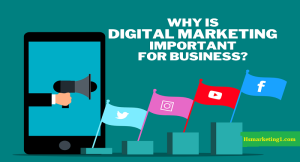
The Rise of Digital Channels
Marketing plays a vital role in a business’s success in the modern world. Among various marketing strategies “Digital Marketing” has emerged as a game-changer due to the widespread accessibility of digital channels. A staggering 5 billion internet users were recorded globally in April 2022. These graphs highlight the massive reach of digital platforms.
Diverse Ways to Connect with Your Audience
Digital marketing offers a plethora of avenues to interact with your target audience effectively. From engaging through social media platforms to connecting via text messages the possibilities are vast. This versatility allows businesses to tailor their approach to suit the preferences of their audience and brand awareness.
Cost-Effectiveness for Small Businesses
One of the most well-known factors contributing to digital marketing’s rising popularity. It is an affordable strategy for small enterprises. Traditional marketing strategies frequently demand significant up-front costs. Companies may initiate campaigns with a low initial budget for digital marketing. Smaller businesses can now compete and prosper thanks to this procedure.
Explore the Differences: B2B vs. B2C Digital Marketing
As a flexible instrument, digital marketing serves both B2B and B2C businesses. However, the methods used for each are very different from one another. Let’s examine the main differences between the use of digital marketing for B2B and B2C marketing.
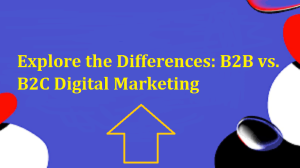
B2B: Nurturing Relationships for Longer Sales Funnels
- B2B clients often take longer to make decisions. Which results in lengthier sales funnels.
- Relationship-building techniques excel in the B2B sphere. Developing credibility and trust with potential customers.
B2C: Emotionally-Driven Content for Short-Term Impact
- B2C customers respond favorably to short-term offers and messages, driven by emotional appeals.
- Content in B2C marketing is crafted to make customers feel good about their purchase decisions.
B2B: Logic and Evidence-Driven Marketing
- B2B transactions rely on logic and evidence to influence decision-making.
- Skilled B2B digital marketers present data-driven content to sway potential clients.
B2C: Establishing One-on-One Connections
- B2C customers value personalized experiences and one-on-one connections with brands.
- Successful B2C marketing often revolves around engaging directly with the individual consumer.
Adopting Strategies to Suit Your Customer Base
- While general trends each company must adapt its digital marketing strategy to its specific customer base. Strategy regardless of whether it is B2B or B2C.
- High-demand B2C products like cars or computers. It may require informative and serious content that challenges the typical emotional focus.
Digital marketing is a fantastic platform that adapts to the unique needs of both B2B and B2C companies. Understanding the successful preferences and decision-making processes of each customer base. It is crucial to devising successful online marketing campaigns. Take a closer look at your current audience to create well-informed and targeted digital marketing efforts. Ensuring your campaigns resonate with the right prospects.
Explore The 10 Most Effective Types of Digital Marketing
There are several different ways to approach digital marketing. Each offers different ways to communicate through digital media. We will discuss 10 of these forms of digital marketing.
1. Search Engine Optimization (SEO)
Search engine optimization (SEO) is a powerful marketing way. That makes sure to manage web pages attractive in search engines. Let’s see at the key elements and value of SEO:
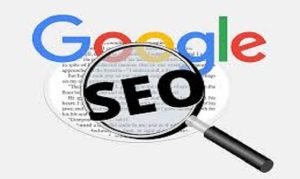
The Science of SEO: Factors that Influence Rankings
- Quality Content: Creating engaging and valuable content is paramount for SEO success. Search engines prefer pages with relevant, informative, and well-written content.
- User Engagement: Keeping users on your site is crucial. High user engagement is measured by factors like time spent on the page and low bounce rates. It signals to search engines that your content is valuable.
- Mobile-Friendliness: With the rise of mobile usage having a mobile-friendly website is essential. Search engines favor pages that offer a soft experience on various devices.
- Outbound Links: The quality of links from other reputable websites to your page plays a significant role in search engine rankings.
The Art of SEO: Navigating the Unpredictable
- Technical SEO: Optimizing the back-end components of your site, such as URL structure, loading times, and fixing broken links, helps search engines better crawl and navigate your website.
- The Unpredictable Nature: SEO is an ever-changing landscape, as search engines like Google frequently update their algorithms. There’s no fixed formula for success, making SEO a blend of strategy and adaptability.
Securing a Spot on the First Page
The main focus of SEO is to rank on the first page of search engine results. Achieving this means that potential customers can easily find your brand. While customers search for relevant products or services. Google, being a major player in the search engine market garners significant attention from digital marketers.
Constant Monitoring and Adaptation
Due to the dynamic nature of SEO, Exact predictions are impossible. To succeed closely monitoring your page’s performance and making timely adjustments to your strategy is essential. This flexibility ensures that your SEO approach aligns with the latest trends in search engine algorithms.
SEO is a fascinating blend of art and science. Requiring a well-rounded strategy based on data-driven research and creativity. While SEO remains an ever-changing landscape. Presence and adaptability will empower marketers to stay ahead and drive online visibility and success
2. Content Marketing
Content marketing is a powerful strategy. It revolves around distributing relevant and valuable content to a target audience. Unlike traditional advertising content marketing offers free value in the form of engaging written materials. The focus is to generate leads and convert them into loyal customers through useful interactions.
The Impact of Content Marketing:
- The significance of content marketing cannot be overstated. As it effectively engages consumers and builds lasting relationships. Surveys reveal that a whopping 84% of consumers expect companies to provide entertaining and helpful content experiences. Many businesses have embraced content marketing. Probably 62% of companies with at least 5,000 employees produce content daily. This approach is held in high regard by marketers. 92% believe that their company values content as an essential asset.
The Art of Crafting Effective Content:
- Making engaging content that connects with the target audience. Native content producers are aware of the value of emotional connection. Whether it’s an engaging social media campaign or a blog post. Effective content creation has a lasting effect on the audience and produces significant outcomes.
Identifying Your Audience:
- To grow in content marketing it’s crucial to identify your target audience. Knowing your audience’s preferences allows you to prepare content that engages them. Whether it’s videos or blog posts diverse content formats can be employed to cater to your audience.
3. Social Media Marketing
Social media marketing is a superb strategy that drives traffic and boosts brand awareness. Users are active on social media platforms and focusing on this marketing approach. Through this they can get significant benefits for businesses.
Deciding which platforms to use depends on your goals and target audience. For instance, LinkedIn may be ideal for finding leads in the FinTech industry. While Instagram might be more suitable for engaging younger B2C consumers.
Key Points:
- Active Audience Participation: Social media marketing thrives on audience engagement and makes it a popular method for capturing attention. It’s heavily recommended by B2C marketers with 96% using it for content distribution. B2B marketers are also embracing social media with 61% increasing their usage this year.
- Valuable Engagement Metrics: Social media platforms offer built-in metrics that help businesses gauge their reach and effectiveness.
- Diverse Goals: Social media marketing goes beyond direct purchases. It often focuses on starting a dialogue with audiences. Especially for brands targeting or offering non-impulsive products/services.
- Best Practices for Success: Crafting high-quality and engaging content. Responding professionally to comments and questions maintaining a consistent posting schedule. Social media channels are key elements of an effective social media marketing strategy.
Social media marketing presents an opportunity for businesses to connect with their target audience. Build brand loyalty and show meaningful interactions. Embrace the power of social media marketing to establish a strong online presence and push your business to new heights.
4. Pay-per-click Marketing (PPC)
Pay-per-click (PPC) marketing is a very useful form of digital advertising. That allows businesses to pay only when their ads are clicked on by users. This cost-effective strategy contrasts with traditional advertising. As it targets individuals who actively engage with the ads. One popular type of PPC is search engine advertising with Google Ads. A widely used platform due to Google’s hold as a search engine.

Understanding the Mechanics of PPC:
- The Instant Auction: When a spot on a search engine results page (SERP) becomes available, an instant auction takes place. An algorithm evaluates and ranks available ads based on factors like ad quality, keyword relevance, landing page quality, and bid amount.
- Top Placement on SERPs: PPC ads are strategically placed at the top of search engine results pages based on the factors mentioned above. This ensures that your ads appear whenever a user searches for a specific query, increasing visibility and potential clicks.
Target Actions and Conversions:
PPC campaigns concentrate on converting certain target actions into sales. These may involve transactions like buying something. Or non-transactional such as subscribing to a newsletter. Through their preferred channels marketers may monitor these conversions to assess the effectiveness of their PPC efforts.
PPC advertising is a very successful digital marketing tactic. By doing this firms can connect with their intended market. Make use of PPC marketing’s strength to draw in quality leads and increase brand recognition. Realize quantifiable results from your digital marketing initiatives.
5. Email Marketing
Email marketing may seem simple at first glance. But its successful execution requires careful planning and consideration. The key to effective email marketing lies in building an effective list. That ensures your emails are wanted and valued by your audience.
To achieve this individualized content in both the body and subject line. Clearly stating the type of emails subscribers will receive. Providing an easy unsubscribe option is a crucial step. Integrating both transactional and promotional emails further enhances the user experience. Making your campaign feel more like a valued service than a mere promotional tool.
The Effectiveness of Email Marketing:
Email marketing has stood the test of time and proven to be a powerful technique. With a remarkable 89% of professionals using it as their most effective lead generator. When combined with other digital marketing techniques. Marketing automation and email marketing becomes even more powerful. Utilizing marketing automation allows you to schedule emails. Ensuring they meet your customer’s needs more effectively.
Marketing To run Great Email Marketing Campaigns:
- Segment Your Audience: creating emails for specific audience segments ensures. That your campaigns interact with the right people increasing engagement and conversions.
- Mobile-Optimization: With the spread of mobile device usage. it’s essential to ensure your emails look good and function well on smartphones.
- Create a Campaign Schedule: Consistency is key in email marketing. A well-planned campaign schedule helps maintain regular communication with your audience.
- A/B Testing: Running A/B tests enables you to experiment with different email elements and optimize your campaigns for better results.
Email marketing remains a highly effective and essential strategy in digital marketing. Incorporating marketing automation further enhances the impact of email marketing. While adapting to best practices ensures successful campaigns that engage customers and drive desired outcomes.
6. Affiliate Marketing
Affiliate marketing is a powerful digital tactic. That offers individuals the chance to earn money by promoting another person’s business. Whether you’re the promoter or the merchant. The process remains the same for both is revenue sharing through commissions.

As an affiliate, you earn a commission every time you successfully drive a sale for the business you’re promoting. If you’re the merchant then you pay affiliates for the sales they generate for your business.
The Mechanics of Affiliate Marketing:
- Commission-based Revenue Sharing: Affiliates receive a percentage of the sales they facilitate, providing them with a financial incentive to promote the merchant’s products or services.
- Versatility in Promotion: Affiliate marketers have various approaches, from reviewing products on blogs or third-party sites to working with multiple merchants.
Connecting Affiliates and Merchants:
- Building Connections: Whether you want to be an affiliate or collaborate with affiliates as a merchant, establishing a connection is the first step. Digital channels designed for affiliate-merchant connections or single-retailer programs can be used for this purpose.
- Making Your Program Attractive: As a retailer, enticing potential promoters involves providing them with essential tools for success. These tools include incentives for excellent results, marketing resources, and pre-made materials.
Affiliate marketing opens up lucrative opportunities for both promoters and merchants. It’s a win-win strategy that enables affiliates to earn money by promoting products they believe in. While merchants benefit from increased sales and brand visibility.
7. Influencer Marketing
Influencer marketing harnesses the power of influential individuals such as celebrities and industry experts. Also, content creators promote your products or services in exchange for exposure. This marketing tactic relies on influencers’ large social media followings.
To reach new audiences and boost your brand visibility for new customers. It is a versatile strategy applicable to both B2B and B2C companies. Who is seeking to expand their reach and connect with potential customers?
However, it is vital to partner with reputable influencers. Who align with your brand values as they basically become ambassadors for your business. The wrong influencer choice can potentially harm the trust consumers have in your brand. Be careful with the selection of the right influencer for your brand.
Understanding Influencer Marketing:
Influencer marketing is a collaborative effort between businesses and influencers. Influencers use their influence, credibility and popularity. To promote products or services to their dedicated fans based on various social media platforms. This approach offers a more authentic and personal touch. It also creates a sense of trust and relatability with the new audience.
Choosing the Right Influencers:
To ensure the success of influencer marketing. It is essential to partner with the right influencers. Reputable influencers with genuine engagement and an audience. That aligns with your target market can significantly impact the brand’s appearance and reach. Through proper research select potential influencers and assess their credibility. Being aware of their authenticity and brand fit is vital before entering into a partnership.
Platforms for Influencer Marketing:
Influencer marketing primarily takes place on social media platforms. Where influencers share sponsored content and product reviews or endorsements with their followers.
Popular platforms for influencer marketing include;
- YouTube
- TikTok
Each platform offers unique advantages based on the target audience and the type of content. Allowing businesses to choose the most suitable channel for their influencer marketing campaigns.
By selecting reputable influencers who genuinely align with the brand. Companies can build trust and expand their online presence and tap into new markets. Partnering with the right influencers on the appropriate platforms. It can be a game-changer for brand awareness and driving successful marketing campaigns.
8. Video Marketing
Video marketing has emerged as a compelling and influential digital marketing strategy. Shows the power of visual storytelling to captivate audiences and boost brand impact. By utilizing videos as a medium businesses can effectively convey their message. Also, showcase products and engage viewers on various online platforms.
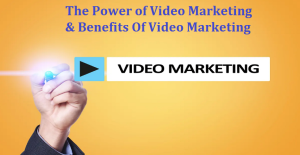
The Power of Video Marketing:
- Captivating Visuals: Videos have an inherent ability to capture attention and evoke emotions. Making them an ideal medium for delivering impactful brand messages.
- Enhanced Engagement: Video content encourages higher levels of engagement compared to traditional text-based marketing. As viewers find it more compelling and memorable.
- Versatility and Creativity: Video marketing allows for diverse formats from explainer videos and products. They also create demos behind-the-scenes glimpses and customer testimonials. The creative possibilities are endless.
- Reach and Shareability: Videos are highly shareable across social media platforms. Extending their reach and potential for viral exposure.
The Benefits of Video Marketing:
- Boosted Brand Awareness: Engaging videos can help businesses reach a wider audience. It also strengthens brand awareness among consumers.
- Increased Conversion Rates: Video content drives higher conversion rates. As it effectively communicates product benefits and inspires action.
- Improved SEO: Incorporating videos on websites and social media enhances SEO rankings. This process always leads to improved visibility and website traffic.
- Enhanced User Experience: Videos provide a more enjoyable and interactive user experience.
The Scope of Video Marketing:
- Social Media Dominance: Social media platforms serve as prime spaces for video marketing. Where businesses can connect with a vast and engaged audience.
- Website Optimization: Embedding videos on websites and landing pages. Enhances user engagement reduces bounce rates and improves conversion rates.
- Live Streaming: The popularity of live video streaming on platforms like Instagram Live and Facebook Live offers brands the opportunity to engage in real time with their audience and engage in authentic interactions.
- Video Email Marketing: Integrating videos into email campaigns can increase open rates and click-through rates. It may be delivering more impactful messages to subscribers.
Video marketing is a versatile and impactful digital marketing strategy that holds immense potential for businesses of all sizes. Choose video marketing as a basic and indispensable part of your digital marketing strategy.
9. Marketing Automation
Marketing automation has revolutionized digital marketing by utilizing software to enhance the efficiency and relevance of advertising campaigns. By automating time-consuming processes, businesses can focus on creating impactful marketing strategies and fostering meaningful interactions with their audience.
The Power of Personalization:
Statistics show that personalization holds great appeal for consumers, with 90% of US consumers finding it appealing. Consumers crave brands that understand them better, and 81% desire a more personalized experience. However, despite the recognition of the value of real-time personalization by 77% of companies, many still struggle to implement it effectively.
The Role of Marketing Automation:
Marketing automation serves as a powerful tool for companies to meet the expectations of personalization. It empowers brands to:
- Collect and Analyze Consumer Information: Marketing automation tools gather valuable data on consumer behavior and preferences, providing insights to craft targeted marketing campaigns.
- Design Targeted Marketing Campaigns: Armed with consumer data, brands can create customized campaigns that resonate with specific audience segments, enhancing engagement and conversion rates.
- Timely Delivery of Marketing Messages: Marketing automation ensures that digital marketing messages are sent or posted at the right times, ensuring maximum impact with the right audience.
10. Mobile Marketing
A digital marketing technique known as “mobile marketing” uses mobile devices like smartphones to interact with audiences. Since most people own smartphones, mobile marketing gives companies an efficient means to communicate with their target market. That increases brand exposure and client engagement.
Mobile marketing allows for personalized and realtime interactions. Ensuring good connections with customers and the overall brand experience.
These types of digital marketing have proven to be highly influential and successful in connecting with audiences. Through this strategy we drive traffic and achieve marketing objectives. Keeping up with the latest trends and incorporating these tactics into a marketing strategy. It can definitely show the brand’s online presence and overall success.
Guide To Creating an Effective Digital Marketing Strategy
Getting started with digital marketing may seem daunting. But by following these steps you can develop a powerful and successful digital marketing strategy. To boost your brand’s presence and drive sales.
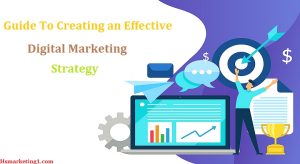
Set SMART Goals:
Begin by defining specific, relevant and timely (SMART) goals. Think about what you want to achieve through your digital marketing efforts. Focus on goals that will propel your strategy forward and lead to reliable results.
Identify Your Audience:
Knowing your target audience is essential for running relevant and engaging campaigns. Conduct market research to understand your audience’s interests and purchasing behavior. This insight will guide your choice of digital marketing channels and content.
Create a Budget:
Allocate your marketing budget wisely to ensure optimal utilization of resources. Consider your SMART goals and the cost of various digital marketing channels. To create a budget that aligns with your objectives.
Select Digital Marketing Channels:
Choose the digital marketing channels that best suit your goals target audience and budget. Options include content marketing, social media (PPC) campaigns and email marketing. A mix of channels may be ideal for reaching a diverse audience.
Refine Your Marketing Efforts:
Analyze the performance data of your campaigns to identify strengths and areas for improvement. Use digital marketing analytics tools to gather data and insights in a main dashboard. This data-driven approach will enable you to refine your strategies and optimize future campaigns.
Trends to Consider:
As digital marketing evolves consider the following trends to enhance your strategy:
- Personalization: Consumers crave personalized experiences. Prepare your content and messaging to address the unique preferences of your audience.
- Video Marketing: Video content continues to gain popularity offering shareable content that captivates audiences.
- Voice Search Optimization: With the rise of voice assistants try to optimize your content for voice search. To reach users who rely on voice commands.
- Influencer Marketing: Collaborate with influencers to convey their influence and reach new audiences.
Creating a digital marketing strategy requires careful planning and analysis. By setting SMART goals for your audience and choosing the right channels. You can build a successful digital marketing campaign by refining your efforts through data analysis. Stay informed about the latest trends. Employ your strategy to meet the needs and preferences of your target audience.



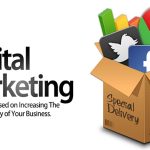


Gifting from the Heart: Celebrating Different Occasions with Thoughtful Presents - Faq-Blog
July 31, 2023[…] gesture goes a long way in showing appreciation and strengthening relationships. In the world of digital marketing, a heartfelt “thank you” to our loyal customers can foster brand loyalty and create […]
The Rise of Bakery Businesses in Dubai - TechyComp- Technology Simplified
August 1, 2023[…] practices offer opportunities. Maintaining quality and consistent talent and staying ahead of digital marketing trends is essential for success. By navigating these aspects with resilience and innovation. Bakery […]
GeoEvent: Your Partner for Exceptional Event Experiences
August 22, 2023[…] services ensure that every word and note is heard with pristine clarity, elevating the auditory and marketing experience for both presenters and […]
From Farm To Vase: How Flowers Brighten Up Homes - The Right Messages
September 22, 2023[…] days, you can purchase the ideal arrangement online, choose from a wide variety of alluring bouquets, and have flowers delivered straight to your […]
7 Best Gifts to Surprise Your Husband - StarWiKiBio
October 28, 2023[…] you have to do is purchase a personalised cushion online. With the convenience of online shopping, customers online can easily browse through a plethora of heart-shaped anniversary cakes, read customer reviews. […]
7 Significant Events for Buying Top-quality Flowers in Dubai - Dydepune.com
October 28, 2023[…] with your special someone in a unique and memorable way. To cater to the diverse preferences of customers online, many flower delivery services in Dubai offer a wide range of tulip varieties and colors, ensuring […]